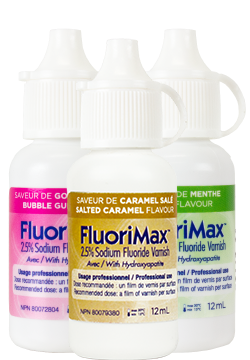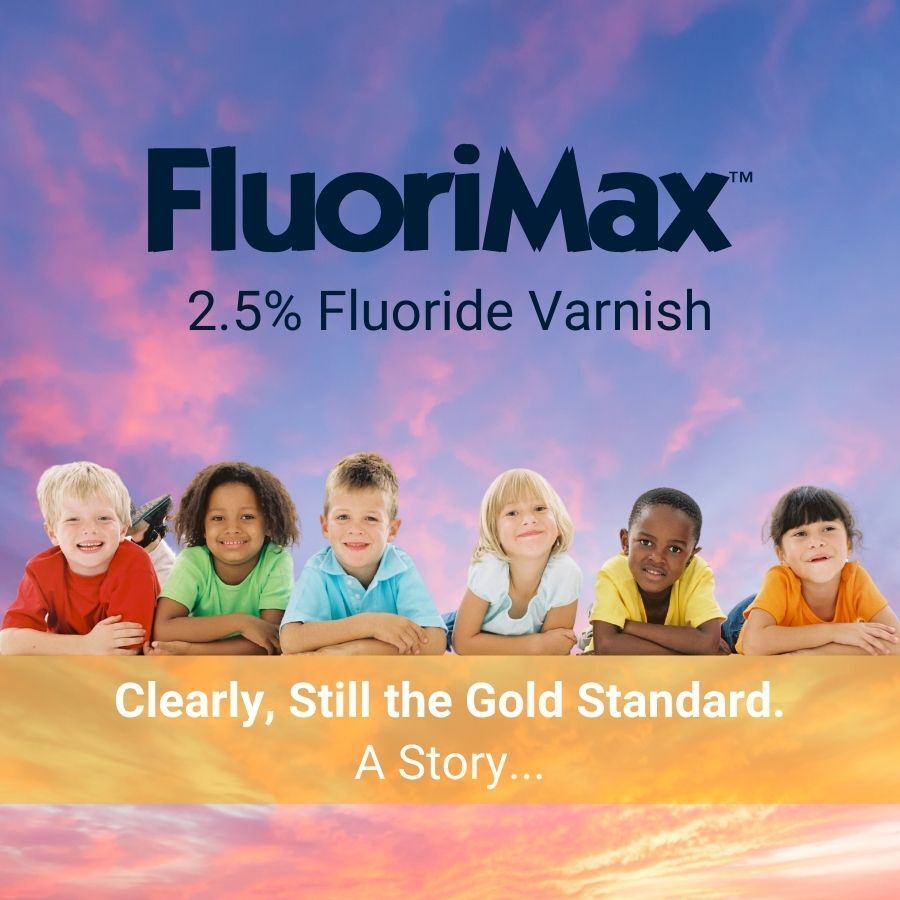
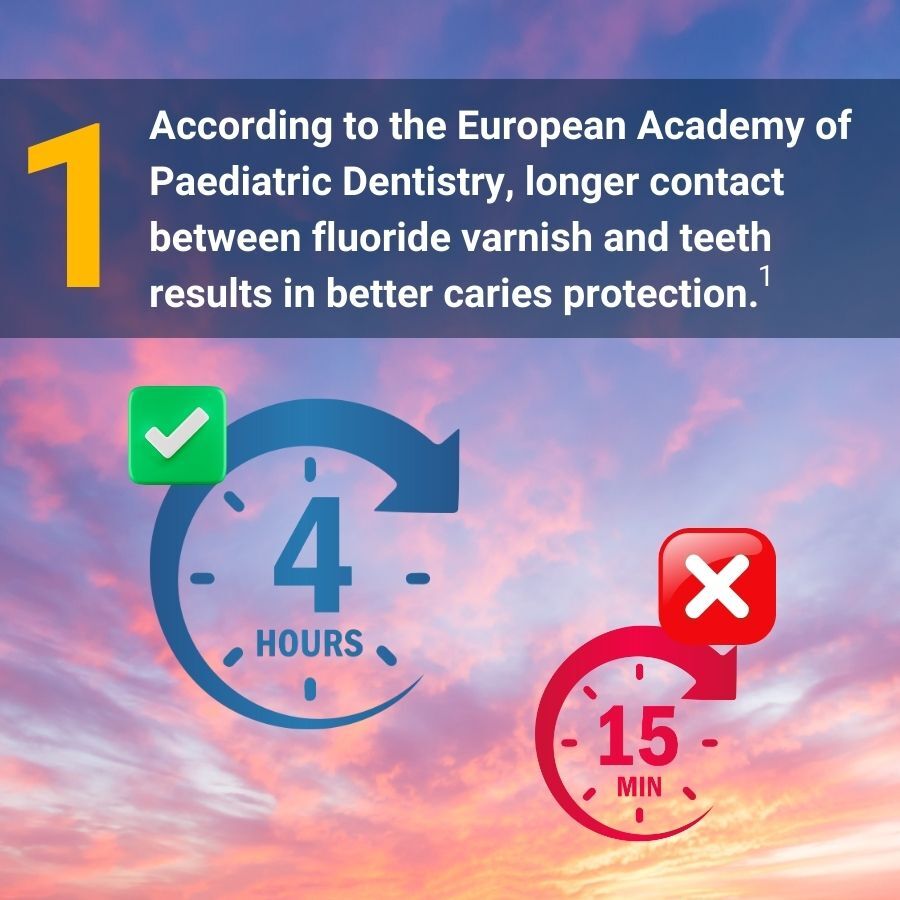
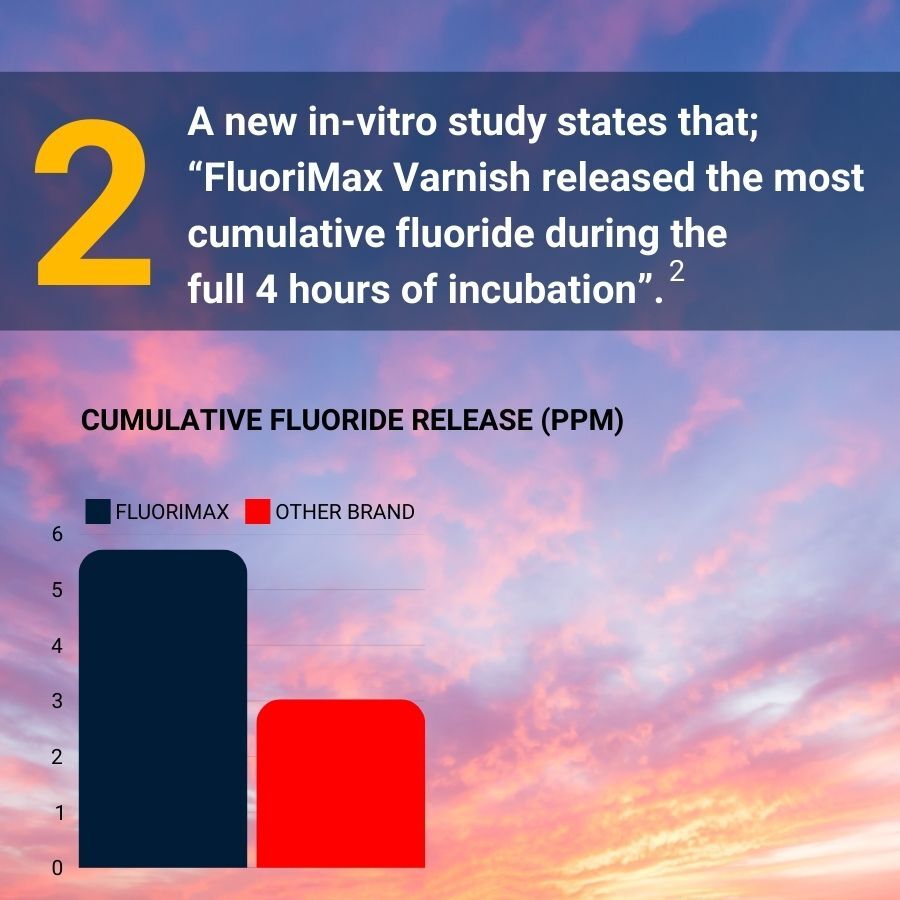
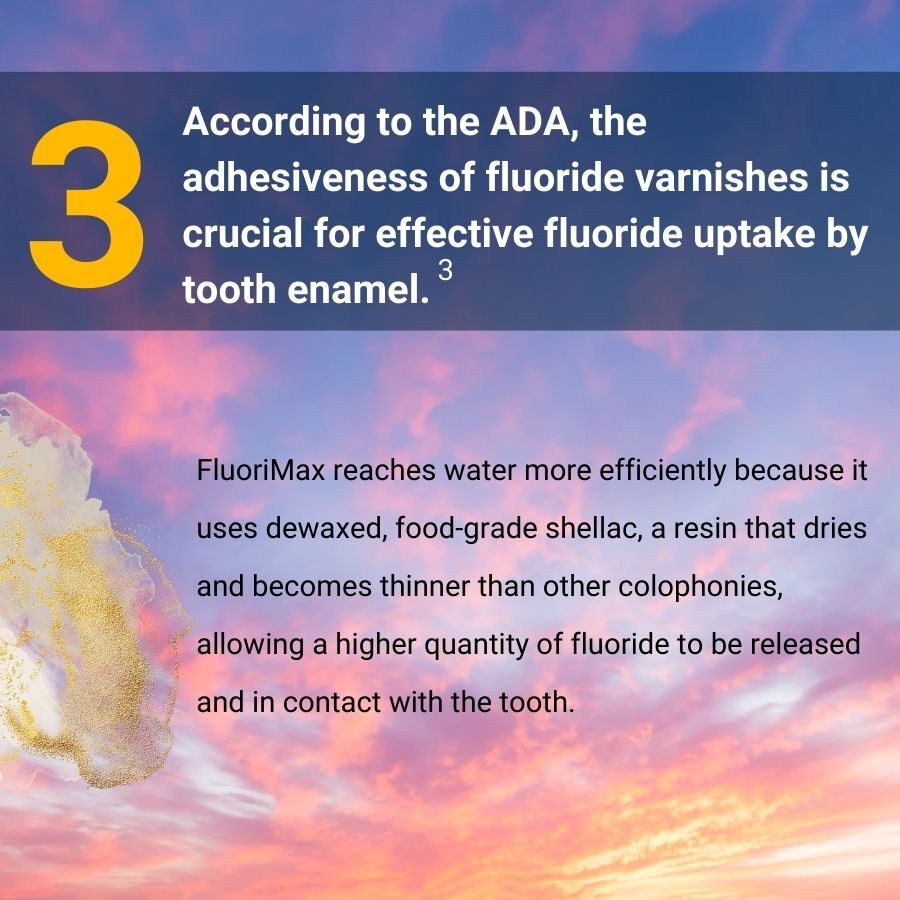
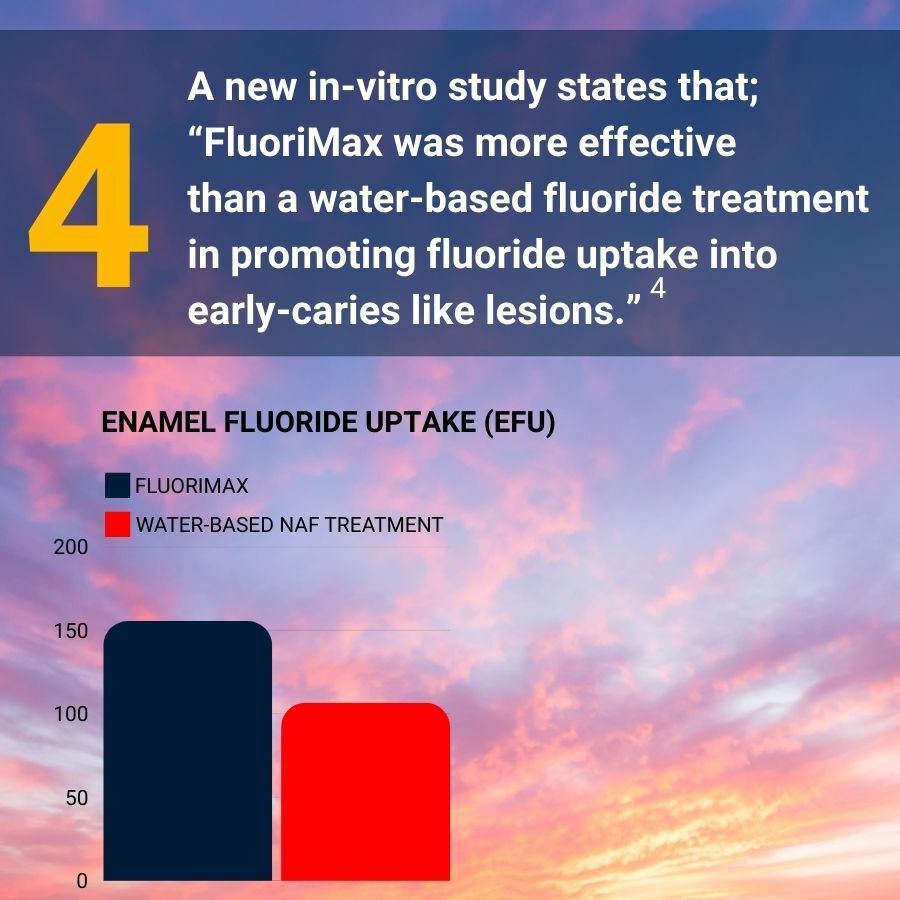
Mechanism of action
FluoriMax’s patented technology is the first varnish to be colophony free. Colophony is the resin component of traditional varnishes that originates in pine trees. Since there is no water in varnishes, fluoride needs to escape the varnish and contact the saliva before it is activated. FluoriMax’s 2.5% sodium fluoride reaches water more efficiently because it uses dewaxed, food-grade shellac, a resin that dries and becomes 7 times thinner than other colophonies, allowing a higher quantity of fluoride to be released and in contact with the tooth. More sodium fluoride touching saliva means more of it is released rather than brushed off with the resin or swallowed in small pieces before it can be released from the colophony.
Benefits
- A 2.5% NaF formulation is not less effective than a 5% formulation
- Colophony free, replaced by shellac Dries and adheres in seconds
- Hypoallergenic
- More comfortable
- Smooth: non-tacky or burning feeling
- Cost-effective:
- 1 kit of 2 × 12 mL bottles ≅ 1,170 drops (test from August 2019)
- Child ≅ 1-2 drops ≅ $0.60 (based on a 2-bottle kit at $349.99)
- Adult ≅ 3 drops ≅ $0.90 (based on a 2-bottle kit at $349.99)
- Hydroxyapatite: protects from acid attacks and keeps enamel strong
- Increased patient compliance
- Most efficient varnish with superior fluoride uptake
- No uni-dose required: dispense only the quantity needed
- Opportunity to replace foam and gel fluorides
- Sweetened with xylitol
Ingredients
Medicinal Ingredient
2.5% Sodium Fluoride
(11,300 ppm F)
Non-Medicinal Ingredients
Shellac, propylene glycol, ethyl alcohol, dibasic sodium phosphate, ammonium phosphate, xylitol, sucralose, calcium hydroxyapatite, flavour.
NPN
80079380
Indications
- Anti-caries
- Desensitizer
Clinical uses
- High risk caries
- Pediatrics
- Tooth sensitivity
Available kits
Single flavour:- 2 x 12ml bottles
- 300 applicator brushes
- 300 mixing wells
- 3 x 12ml bottles (1 x of each flavour)
- 500 applicator brushes
- 500 mixing wells
- 70 × 0.3 mL ampules (bubblegum only)
- 70 applicator brushes
Flavours
- Bubble gum
- Mint
- Caramel
- Naturally unflavoured
- Cotton candy
Directions for use
Bottles & Kits
For the first use, replace the storage cap with the flip-top dropper cap.
- A prophylaxis is not required, however, removal of excessive plaque or calculus may be beneficial.
- Immediately prior to application, shake the bottle vigorously for 15 seconds.
- Hold the bottle upright and flip open the dropper cap.
- Quickly invert the bottle and dispense the desired amount into the mixing well. Quickly turn the bottle right side up to minimize dripping along the dispensing tip. Excess varnish on the dispenser can be wiped away with an alcohol wipe.
- Recommended drops are:
- Primary dentition: 1 drop
- Mixed dentition: 1-2 drops
- Permanent dentition: 2-3 drops
- Leave the teeth moist, but immediately before application have the patient swallow or use suction to remove any pooled saliva. If the dentition is dry, have the patient swish with water, then suction.
- Dip the applicator brush into the mixing well. Do not hold in the well and supersaturate the brush – this can lead to white streaks and over application. Remove excess from brush.
- Retract the cheek on one side of the mouth and start with the bottom arch. Make one swipe only, from the posterior to the midline on the buccal/labial surface of one quadrant. This will provide complete tooth coverage as the varnish flows and adheres beyond the brush width. If you see white streaks or if your patient tastes a strong flavor after application, you have over-applied. Do not exceed the recommended dose. Repeat steps 6 and 7 on the top arch and then on both arches of the other side of the mouth.
- Hold the cheek away from the teeth for 3-5 seconds after application to allow FluoriMax varnish to completely dry and harden.
Pediatric Application:
For primary dentition, have the patient bite together. Splay the brush bristles, allowing them to touch both upper and lower arches simultaneously. Make one swipe only from posterior to the midline on the buccal/labial surface. Repeat the procedure on the other side of the mouth.
Patient Instructions:
For optimal results, advise the patient to avoid alcohol, brushing, and flossing for 4 hours. A normal diet can resume immediately since FluoriMax varnish forms a tenacious tooth bond.
Unit-Doses
- A prophylaxis is not required, however, removal of excessive plaque or calculus may be beneficial.
- Immediately prior to application, shake the ampule vigorously for 15 seconds.
- Twist the brush into the ampule until it snaps in place.
- Leave the teeth moist, but immediately before application have the patient swallow or use suction to remove any pooled saliva. If the dentition is dry, have the patient swish with water, then suction.
- Turn the brush down and gently squeeze one drop of varnish onto a gauze or other disposable to moisten the brush. Do not supersaturate the brush as this can lead to white streaks and over application.
- Retract the cheek on one side of the mouth and start with the bottom arch. Make one swipe only, from the posterior to the midline on the buccal/labial surface of one quadrant. This motion will provide complete tooth coverage as the varnish flows and adheres beyond the brush width. One coating is all that is needed per surface. If you see white streaks or if your patient tastes a strong flavor after application, you have over-applied. Do not exceed the recommended dose. Repeat steps 5 and 6 on the top arch and then on both arches of the other side of the mouth.
- Hold the cheek away from the teeth for 3-5 seconds after application to allow FluoriMax varnish to completely dry and harden.
Pediatric Application:
For primary dentition, have the patient bite together. Allow the brush bristles to touch both upper and lower arches simultaneously. Make one swipe only from posterior to the midline on the buccal/labial surface. Repeat the procedure on the other side of the mouth.
Patient Instructions:
For optimal results, instruct the patient to avoid alcohol, brushing, and flossing for 4 hours. A normal diet can resume immediately since FluoriMax varnish forms a tenacious tooth bond.
2.5% VS 5% NAF VARNISH
FLUORIMAX IS A SODIUM FLUORIDE VARNISH INDICATED BY HEALTH CANADA

HEALTH CANADA, ONE OF THE MOST STRICT HEALTH AGENCIES IN THE WORLD...
- Recognizes FluoriMax as an anticaries agent
- Classifies it in the same category and equivalent to all other sodium fluoride varnishes
WHY ARE ALL VARNISHES 5% SODIUM FLUORIDE?
The first studies made 20 years ago on fluoride varnishes were done with 5% NaF formulations because it was the only formulation available on the market. There was no rational to choose 5% instead of another concentration.
INDEPENDENT SCIENTIFIC DATA SHOWING SAME OR BETTER EFFECT OF 2.5% NAF VARNISHES ON 5% NAF 6, 7, 8
1980’s and 1990’s :
A series of in vitro and in vivo studies established statistical equivalency between 2.5% NaF and 5% NaF varnish formulations
1994 :
In-Vivo 3 Year Clinical Study Compared the effects of a 5% NaF varnish (Duraphat) and a 2.5% varnish (experimental Duraphat) applied three times annually 9
“It can be stated at a reasonable level of certainty that if a difference in the efficacy of the two varnishes exists, it is probably minute.”
2013 :
In vitro research model created using synthetic HAp discs to test “saturation theory” 1
- Determine the NaF concentration that yields the optimal level of enamel uptake
- Determine whether the release rate of fluoride into saliva is predictive of the fluoride uptake into enamel. “In this study, optimal (NaF) is 2.5% for saturating all the available tight and loose binding sites of the HAp disc.”
Reasons to switch
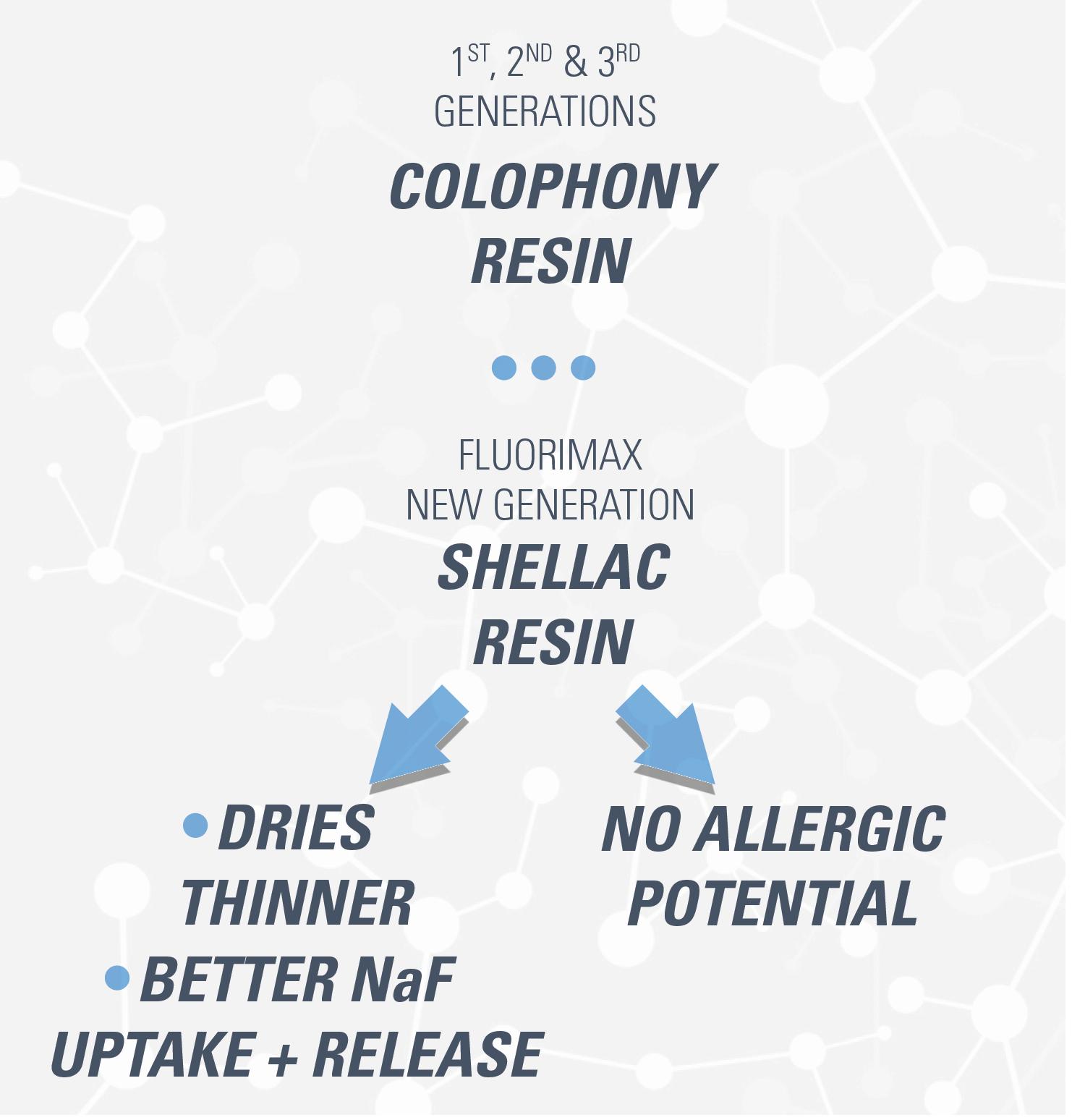
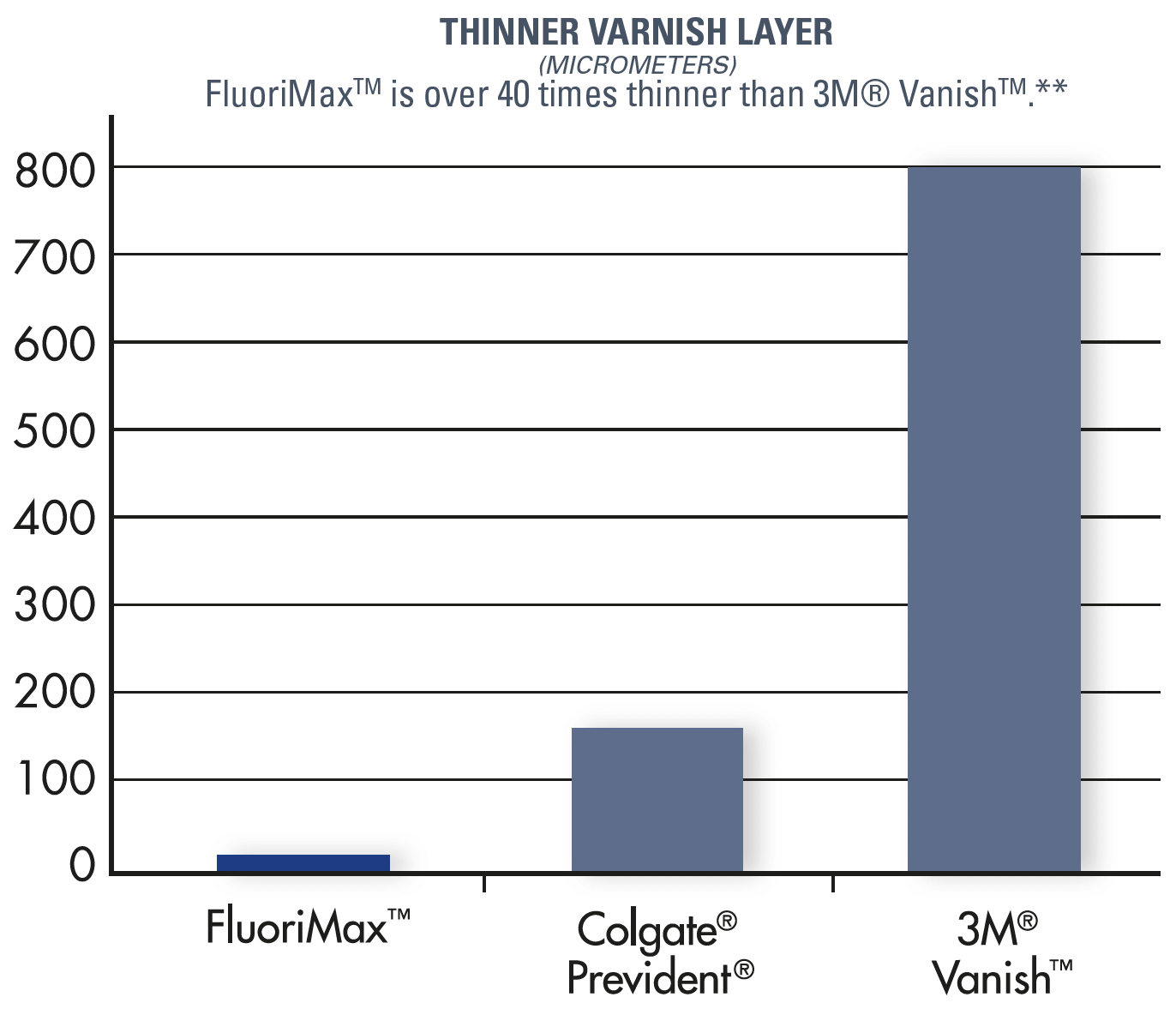
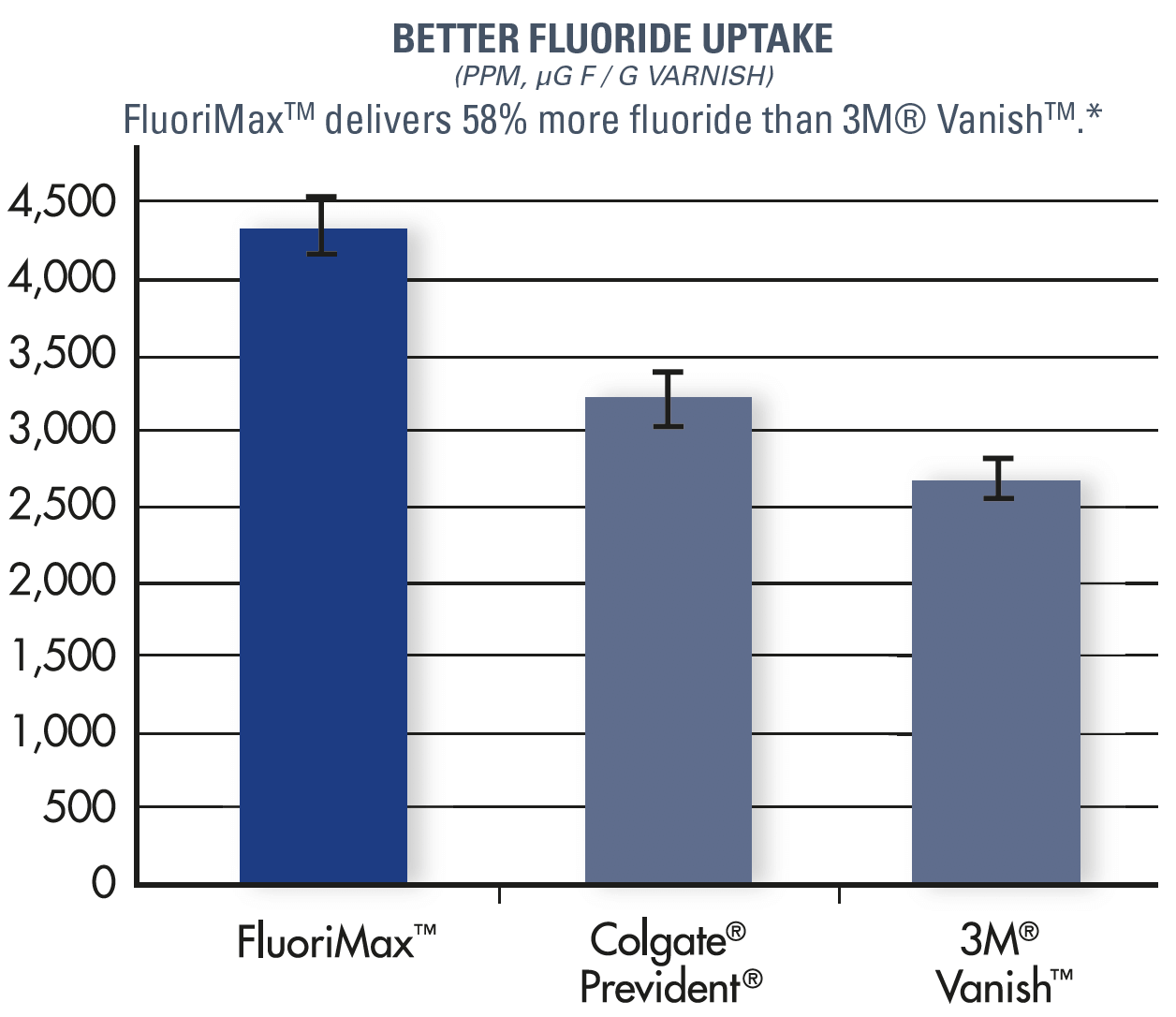

Featured Publications
Quantitative In Vitro Dentin Tubule Blockage Evaluation of Fluoride Varnish Applications
Enamel Fluoride Uptake Study Number 28 FDA Method #40
A NEW GENERATION OF FLUORIDE VARNISH IS COMING TO YOU!
Fluoride Varnish Thickness Test #3
In vivo Study: Fluoride Varnish Migration and Salivary Fluoride
Fluoride uptake from professional fluoride applications applied directly onto lesions
Fluoride bioavailability in close proximity to professional fluoride applications
Demineralization Protection of a New Protective Coating
Fluoride Release and Uptake into Hydroxyapatite from Experimental Dental Varnish
Caries incidence after topical application of varnishes containing different concentrations of sodium fluoride: 3-year results
Effects of a sodium fluoride solution and a varnish with different fluoride concentrations on enamel remineralization in vitro
Caries-Preventive Effect of Fluoride Varnish with Different Fluoride Concentrations
Prevention of Rat Fissure Caries by Sodium Fluoride Varnish (Duraphat®) with Different Fluoride Concentrations
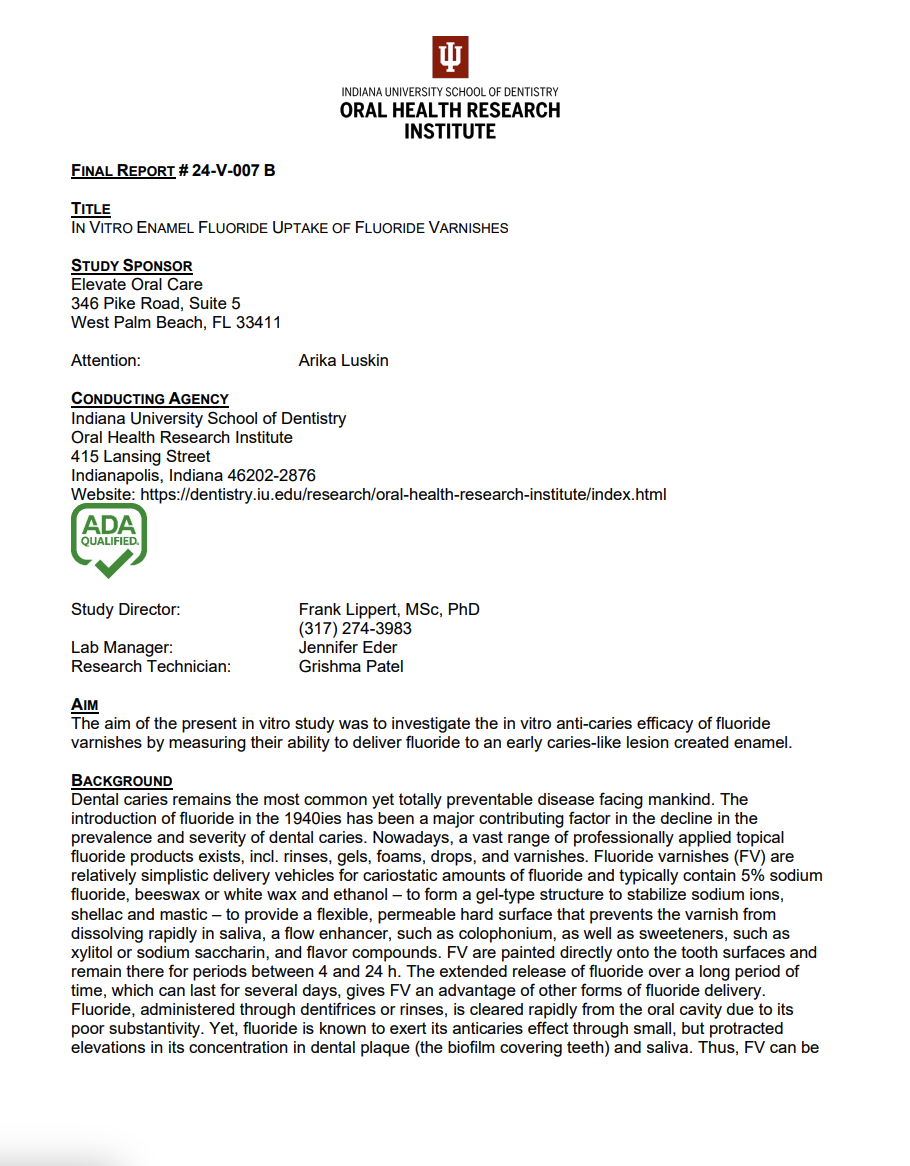
In Vitro Enamel Fluoride Uptake of Fluoride Varnishes
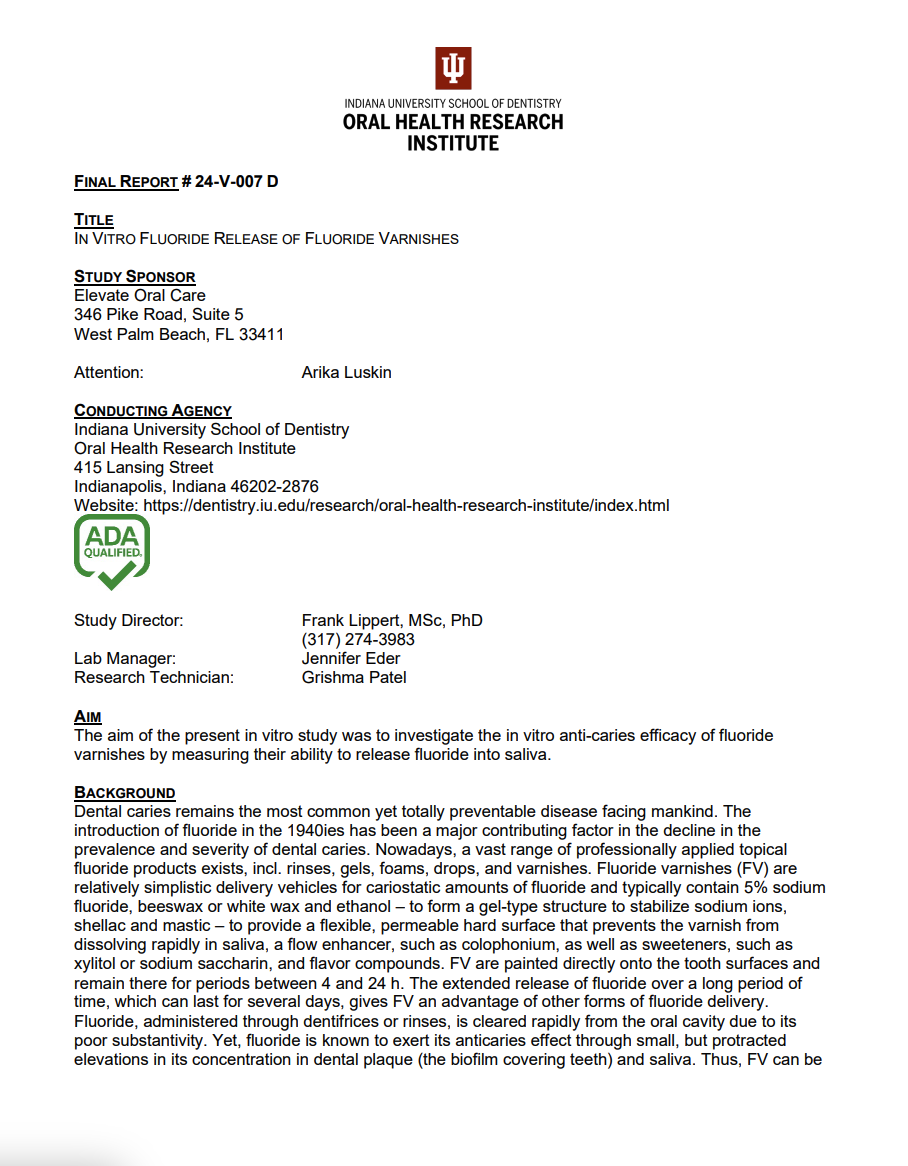
In Vitro Fluoride Release of Fluoride Varnishes
References
- I. Ahmed, S.S. Coleman, C.M. Carey, Fluoride Release and Uptake into Hydroxyapatite from Experimental Dental Varnish, University of Colorado [LINK]
- George K Stookey, Bruce R. Schemehorn, Thomas J. Keefer, Final Report: Enamel Fluoride Uptake Study Number 28 [linLINKk]
- Sylvie Martel, A New Generation of Fluoride Varnish is coming to you! Oral Hygiene Magazine [LINK]
- Thomas J. Keefer, Final Report: Fluoride Varnish Thickness Test #3 [LINK]
- George K Stookey, Bruce R. Schemehorn, Thomas J. Keefer, Quantitative In Vitro Dentin Tubule Blockage Evaluation of Fluoride Varnish Applications [LINK]
- Seppa, 1988
- Haugejorden Ola and Nord Alf, 1990
- Seppa, 1998
- Seppa, 1994
MSDS
Consult MSDS


